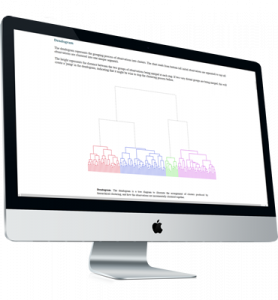
Positioning
Get answers for the most frequently asked questions about the Enginius positioning module. For a quick overview, we suggest you check the introductory video first.
Positioning in a nutshell

Positioning analysis enables firms to develop differentiation and positioning strategies for their products.
By using this tool, managers can visualize the competitive structure of their markets as perceived by their customers. Typically, data for mapping are customer perceptions of existing products (and new concepts) along various attributes, as well as customer preferences for those products.
Positioning Analysis also helps firms to answer such questions as:
– Based on customer perceptions, which target segments are the most attractive?
– How should we position our new products with respect to our existing products?
– How do our customers view our brand?
– What product name is closely associated with the attributes that our target segment perceives as desirable?
– Which brands do our target segments see as our closest competitors?
– What product attributes are responsible for the perceived differences between products?
– How would changes in a product’s perceived attributes alter the product’s market share?

Download the tutorial

To download the Enginius tutorial in pdf format: (1) Follow the link below. It will open an example data set, then (2) Click on the link in the upper-left corner of the screen.
Featured videos
In this video tutorial, you will see how easy it is to create a positioning map on the fly, using the inputs of a few individuals only.
Frequently asked questions
The primary objective of positioning analysis is to help develop a positioning or re-positioning strategy for a firm, i.e., for the firm to articulate how to be different from competitors, but in a way that is meaningful to the target customers.
Indeed, such an objective could be achieved without using maps, or even without any analytics.
However, the maps have been found to be very useful for summarizing a large amount of perceptual and preference data of customers that are relevant for positioning.
By using these maps, we can expect the resulting positioning strategy to actually make the brand/product/firm more appealing to the target customers.
Perceptual maps help visualize the beliefs or attitudes that customers in a target segment have for the set of competing alternatives available to them.
This type of visualization can help in identifying “gaps in the market” where the firm’s products could potentially be positioned.
Preference maps help visualize customers’ preferences for the competing alternatives –e.g., the proportion of customers who prefer A to B, or B to C, or A to B & C, etc.
Such maps can help identify “the market in a gap” (i.e., whether the firm’s product would garner enough sales if positioned in a gap).
Joint-space maps help jointly visualize both perceptions and preferences and enable marketers to identify the valuable gaps in the market where their products could potentially be positioned.
3D maps are more difficult to visually interpret than 2D maps. Therefore, if we have an adequate 2D map (e.g., more than 70% of the variance in the data is captured by the map), it pays to carefully evaluate the positioning implications from the 2D map.
In some cases, however, incorporating the third dimension into the map may reveal opportunities (especially for a smaller share brand/product).
If the incremental variance (on a scale of 0 to1) explained by including the third dimension is less than the variance attributable to a single perceptual variable (= 1/n, where n is the number of perceptual variables), then a 2D map is more than adequate for the analysis.
This dilemma is referred to as the mind-share, market-share problem. The product itself is highly preferred, but a competitor might be perceived to be just a little better, and the market gravitates to the competitor (e.g., the classic Avis versus Hertz story).
This situation is most likely to occur when using the “first-choice” rule to compute market share.
In this situation, the firm could explore several possible strategies: For example, it could consider targeting a niche segment within the broader target segment that clearly prefers the firm’s product over that of the better competitor, or it could develop its product features (i.e., re-position the product) in a way that it appeals to more customers in the target segment, and at the same time, the new position is not attractive for the competitor(s) due to the possibility they could lose substantial market share.
Those in green are statistically significantly (at 95%) above the remaining population mean; those in red are statistically significantly (at 95%) below the remaining population mean.
The main benefit of an analytical approach to positioning/re-positioning is that the firm does not succumb to internal wishful thinking about its appeal to the target segment. Instead, it relies on a systematic customer-focused approach to explore attractive positioning options that the target segment would be willing to “grant” the firm.
Finding an attractive “slot” in the minds of target customers is a major challenge especially when there are entrenched competitors in the market.
A well-executed positioning analysis should result in a clear positioning statement (see an example template below), and a marketing plan to achieve that positioning – the marketing plan is based, in part, on the product/brand features corresponding to the selected position.
For [target segment], the [product/concept] is [most important claim] because [single most important support].
Here is an example:
For [females 18-49 who possess dry damaged hair and believe they cannot achieve truly healthy/shiny hair] Pantene is a [hair care system (shampoo/conditioner/styling aids)] that offers [hair so healthy it shines] because it [penetrates from root to tip through its patented Pro-Vitamin B5 formula].




